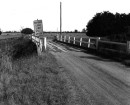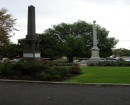Seymour Railway Precinct
Wimble Street crn.Delatite Street, SEYMOUR VIC 3660 - Property No 101455
-
Add to tour
You must log in to do that.
-
Share
-
Shortlist place
You must log in to do that.
- Download report
Statement of Significance
The history and description that precedes this Statement of Cultural Significance is the source of the evidence for the statement below.
The Seymour Railway Precinct is historically significant at the LOCAL level and STATE level (AHC criteria A.4). The precinct contains a wide range of structures which demonstrate the historical importance of the railway to Seymour which once supported a third of its population and the importance of Seymour to the railway particularly through the broad gauge era. The imposing station building with its large refreshment room testifies to its past importance as a staging point on the Melbourne to Wodonga line and as the junction of the north east and north central lines. The collection of railway related houses and recreational buildings and park around the station also reflects the importance of the railway to the social and economic life of the town.
The locomotive turntable which once serviced a round house which grew to 20 bays is evidence of Seymour's significance as the one time principal repair depot for these lines as well as of its role in supplying ready fired locomotives for the next stage of the journey to Melbourne or Sydney. The large sheds which were serviced by the mobilisation siding and rail yards together with the adjacent associated buildings, the ordnance magazines and with the formation, alignment, and culvert of the siding itself are physical demonstrations of Seymour's role between the two world wars as the place of mobilisation for all Victorian troops and of the critical, but often ignored problems of logistic support for a citizen army when it receives its mobilisation orders.
The precinct is aesthetically significant at the LOCAL level (AHC Criterion E.1) for the design of the two storey polychrome brick Victorian station building incorporating station masters residence including the design of the restored refreshment rooms; the stripped classical interwar design of the Victorian Railway Institute building; the views from the Station Street shopping strip into the railway complex, and the views from Progress residential precinct, into the railway precinct and through to the Commercial precinct. The view from Mobs Siding along the railway reserve to the main station complex is an important visual link between the station and the mobilisation complex.
The precinct is of scientifically significant at the STATE and the LOCAL level.(AHC Criterion F1.). The Railway turntable is of STATE significance as a rare if recent example of one of the largest extant turntables in the State.
The precinct is of technical significance at the local level for its collection of railway structures and equipment, for the design and construction of the P type Hut which is representative of the standard design sleeping and stores huts built by the Australian Army in their thousands prior to and during World War 2, for the unusual design and construction of the two remaining large timber and corrugated iron storage sheds and for the design of the magazines which incorporate specialist features such as unenclosed eaves to encourage any accidental explosion to remove the roof rather than breach the walls.
The precinct is socially significant at the LOCAL level ( AHC Criterion G.1)
The collection of railway related structures at the Railway Heritage Centre and the existence of the centre itself is an expression of how the town's significant railway past lives on in the enthusiasm of a number of its citizens. The railway buildings and infrastructure also create important visual evidence of the great employer in Seymour with the commercial precinct to the north, and the residential areas to the north and south of the railway precinct.
The Spirit of Progress Park, the J.W.Elliott Reserve the preserved steam locomotive, the centenary tree, and plaques celebrating these places are significant testimony to both the official recognition of the role of the railway in the history of Seymour and enthusiasm of the community to participate in celebrating that relationship.
The Victorian Railway Institute illustrates the strong social importance of the railway employer in Seymour, to provide a place for learning, dancing, billiards, tennis, bowls and other social activities, near to the place of work for railway employees, their families and visiting soldiers in the town.
Overall, the Seymour Railway Precinct is culturally significant at the LOCAL level with some elements within it, of STATE Significance.
Sourced by Lorraine Huddle P/L 2006
-
-
Seymour Railway Precinct - Physical Description 2
Building, Industrial, Infrastructure, Miscellaneous
Seymour Railway Precinct - Physical Description 1
Mob Siding (Mobilisation Siding) Army Camp, built from corrugated iron round the 1930s-40s. Large complex with evidence of railway.
Consider including the railway reserve to the station and the brick culvert over the creek. (Database no 1255)Seymour Railway Precinct - Historical Australian Themes
3.8.6 Building and maintaining railways
Veterans Description for Public
Seymour Railway Precinct - Veterans Description for Public
The Seymour Railway Precinct demonstrates the historical importance of the railway to Seymour which once supported a third of its population and the importance of Seymour as a military area during the First and Second World Wars. The imposing station building with its large refreshment room testifies to its past importance as a staging point on the Melbourne to Wodonga line and as the junction of the north east and north central lines.
The precinct includes a significant collection of railway structures and equipment such as the P type Hut. This hut is representative of the standard design of sleeping and stores huts built by the Australian Army in their thousands prior to and during the Second World War. The unusual design and construction of the two remaining large timber and corrugated iron storage sheds, and the magazines incorporate specialist features such as unenclosed eaves to encourage any accidental explosion to remove the roof rather than breach the walls.
The locomotive turntable which once serviced a round house which grew to 20 bays is evidence of Seymour as the one time principal repair depot for these lines as well as of its role in supplying ready fired locomotives for the next stage of the journey to Melbourne or Sydney. The large sheds which were serviced by the mobilisation siding and rail yards together with the adjacent associated buildings, the ordnance magazines and with the formation, alignment, and culvert of the siding itself are physical demonstrations of Seymour's role between the two world wars as the place of mobilisation for all Victorian troops and of the critical, but often ignored problems of logistic support for a citizen army when it receives its mobilisation orders.
Also in the precinct is the Victorian Railway Institute which provided a social hub for learning, dancing, billiards, tennis, bowls and other social activities, near to the place of work for railway employees, their families and visiting soldiers in the town.Heritage Study and Grading
Mitchell - Mitchell Shire Heritage Study
Author: Lorraine Huddle Pty Ltd
Year: 2006
Grading: Local
-
-
-
-
-
Seymour Railway Precinct
 Vic. War Heritage Inventory
Vic. War Heritage Inventory
-
1) ST. ANDREWS HOTEL AND 2) CANARY ISLAND PALM TREE
 Nillumbik Shire
Nillumbik Shire
-
-









